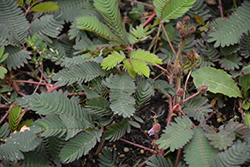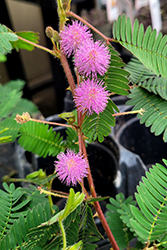Height: 18 inches
Spread: 3 feet
Sunlight:
![]()
![]()
Hardiness Zone: (annual)
Other Names: Sleepy Plant, Humble Plant, Touch-me-not
Description:
This creeping annual or perennial flowering plant produces delicate, fern-like leaves which fold into themselves when touched; produces fluffy pale lilac flowers in spring; may spread aggressively and become weedy in frost free climates
Ornamental Features
Sensitive Plant features dainty spikes of lilac purple pincushion flowers with white tips along the stems from mid spring to late summer. Its attractive tiny narrow bipinnately compound leaves emerge light green in spring, turning bluish-green in color the rest of the year.
Landscape Attributes
Sensitive Plant is an herbaceous annual with an upright spreading habit of growth. Its relatively fine texture sets it apart from other garden plants with less refined foliage.
This plant will require occasional maintenance and upkeep, and is best cleaned up in early spring before it resumes active growth for the season. It is a good choice for attracting bees and butterflies to your yard, but is not particularly attractive to deer who tend to leave it alone in favor of tastier treats. Gardeners should be aware of the following characteristic(s) that may warrant special consideration;
- Spreading
- Invasive
- Insects
Sensitive Plant is recommended for the following landscape applications;
- Rock/Alpine Gardens
- General Garden Use
- Groundcover
Planting & Growing
Sensitive Plant will grow to be about 18 inches tall at maturity, with a spread of 3 feet. Its foliage tends to remain dense right to the ground, not requiring facer plants in front. Although it's not a true annual, this fast-growing plant can be expected to behave as an annual in our climate if left outdoors over the winter, usually needing replacement the following year. As such, gardeners should take into consideration that it will perform differently than it would in its native habitat.
This plant does best in full sun to partial shade. It is very adaptable to both dry and moist growing conditions, but will not tolerate any standing water. It is considered to be drought-tolerant, and thus makes an ideal choice for a low-water garden or xeriscape application. It is not particular as to soil type or pH. It is highly tolerant of urban pollution and will even thrive in inner city environments. This species is not originally from North America, and parts of it are known to be toxic to humans and animals, so care should be exercised in planting it around children and pets. It can be propagated by cuttings.


